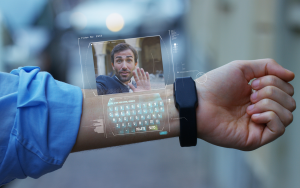Researchers take the first steps towards the development of human-digital interfaces

Just over a decade ago, the idea of wearing a smartwatch to monitor our jogging speed and heart rate, while listening to music, checking e-mails and receiving weather alerts would have sounded like something out of a vintage Star Trek episode. And yet, in this short span of time, we have seen the rise to dominance of smartphones and tablets and the steady development of wearable technology devices such as smartwatches.
Wearables
A research report by the World Economic Forum entitled “Technology and Innovation for the Future of Production” has identified five types of technology that will characterize our short-term future: wearables, artificial intelligence, the Internet of Things, advanced robotics and 3D printing. Moreover, the real value and power of these five technological sectors is convergence. As we integrate new technology, we shape the future.
Currently, the wearables market is nearly completely focused on fitness and health monitoring applications and devices, but applications are being developed for a wide range of different uses, spanning from business aids to life-hacking systems, including an application that promises to alert couples to fights-in-the-making by measuring body biometrics!
From a purely technological point of view, wearables are becoming increasingly miniaturized and researchers are currently working on flexible, printed “circuit boards” in films that will be able to be applied to our skin as e-tattoos.
Electronic Tattoos
Researchers at top universities around the world are currently working on developing tattoos, made of elastomeric nano-films, that can be applied to the human body as tattoos to control computers, smartphones and other wearable devices. These printed circuits are so thin that they are virtually indistinguishable from traditional tattoos and just as comfortable.
E-tattoos, which are based on the molecular assembly of biomaterials, are pushing the very fundamental concepts of wearable technology: user-friendly comfort and simplification. These elastic circuits will adhere to our skin and function for a few days, before needing to be replaced.
Indeed, researchers posit that this new generation of wearables will evolve from, for example, alerting us to the need to take drugs to directly releasing active ingredients into our skin as necessary or in emergency situations (i.e., reviving car accident victims who have fainted).
On a more mundane level, our bodies will be transformed into the biological controllers of our digital devices. Specific locations on our body (fingers, knuckles, palms) and even on our skin (beauty spots and scars) will be matched to the electronic tattoos to create an easy-to-remember biological interface with which to launch apps, control volume and send messages, while our smartphones rest in our pockets. Another significant step forward towards safety and security that will allow us to keep our hands on the steering wheel, until self-driving cars eliminate this need all together!
3D Printing
Experts posit that within a decade or so we will be able to custom print our own electronic tattoos directly at home, based on our needs and desires, while we sip our morning coffee.
In fact, researchers at Waseda University in Japan have already devised a “simple” inkjet printer that prints a nano-sheet with conductive ink that is 120 times thinner than a human hair and capable of hosting conductive wiring that is flexible enough for comfortable use on our skin. The steady progress of printing technology will transform what now seems as futuristic into yet another form of household technology.
Technology is clearly moving from the outside, towards the inside, of our bodies. This will be the first step towards the creation of true human-digital interfaces. And then, the world will truly be “at our fingertips.”